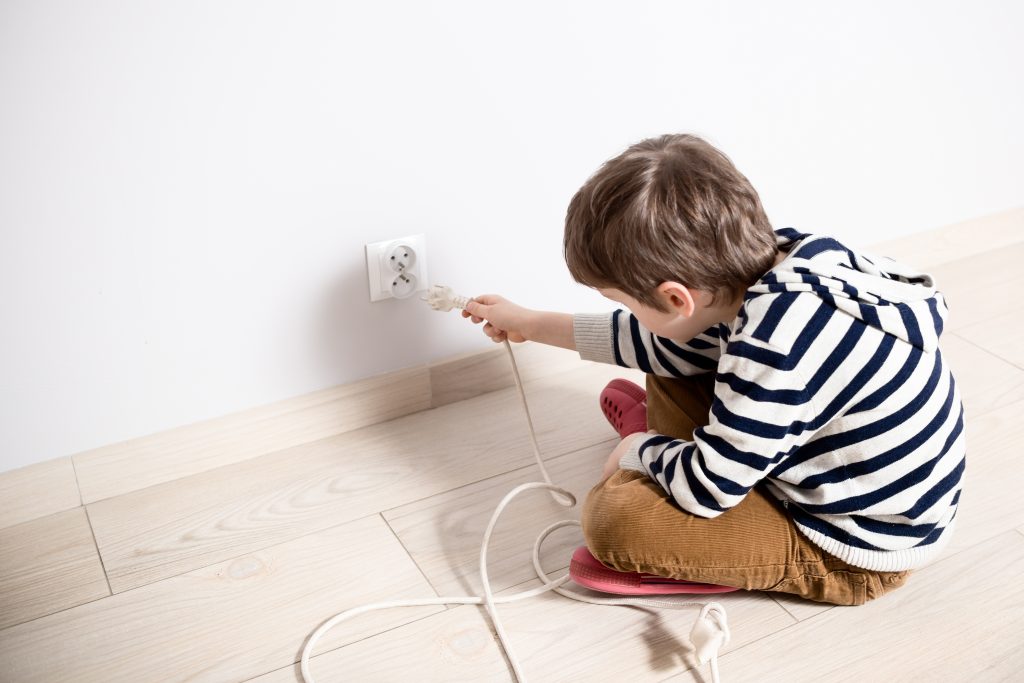
One constant reality of our tech world is the tangled web of cords, wires, and cables that connect, charge, and power our electronic devices. Even our lamps can have long, twisty cords. With these seemingly small threats, it can be tricky to know how to keep your child safe at home. For the average adult, the biggest risk is tripping, which can lead to broken limbs if you’re unlucky. But for our kids the repercussions could be much more serious.
Toddlers and, yes, our pets, love to chew and tug on cords. If they are strong enough, they can pull over furniture or unplug outlets. Like with pull strings on blinds, another very real risk is suffocation. So let’s look at how to keep your toddler safe.
Outlet Safety
Let’s start with where electricity first enters our homes. Outlets are everywhere in our houses and there’s no way we can live without them. Babies and toddlers are curious, and part of that curiosity has been found to lead to poking long, skinny objects into outlets. Not good. Not good at all. Luckily, the fixes are pretty simple.
- Block access. If possible, move furniture or boxes in front of outlets so your baby or toddler can’t reach the outlet. See, pretty simple. If your baby can’t reach the outlet, they can’t poke or play with it.
- Outlet Plugs. These outlet protections fit into the outlet exactly like you are plugging in an appliance. They are small enough to pack with you if you are traveling, but a downside is that toddlers can learn to remove them.
- Sliding outlet covers. These outlets work similar to your average, three-pronged outlet, but with one important advantage, the cover slides open when you plug something in and automatically closes when you pull them out. They are easy to install, replacing your original outlet plate, so they do require a screwdriver.
- Outlet shield or cover. If you don’t want to install a new outlet plate, another easy option is an outlet shield or cover. This covers the outlet completely with either a box or a plate depending on your needs. Be careful though, like with the outlet plug, they are simple enough for a toddler to figure out how to remove.
- Powerstrip covers. If you have a power strip, you have a different kind of problem. Outlet plugs or power strip covers can help minimize the risk but the ideal is to make sure the entire strip is out of reach of toddlers.
Now that we’ve figured out what to do for outlet safety , what can we do about cord safety? Cords are flexible, which leads to some unexpected problems. Keeping them from being chewed on by toddlers or pets is also critical. Let’s look at some ways to manage excessive cord lengths and out of control wires to maximize toddler safety in your home.
- Bundles. A tangled ball of cords in a drawer or in the corner of your room isn’t ideal. Set aside some time to untangle any cord piles and organize them. Bundling them up and securing them can also improve their life span.
- Tape. If you have a cord that is too long and you can’t manage the excess, an easy step is to wind it shorter and tape it into a secure bundle. This can then be affixed out of reach of toddlers. If you have a cord running across the floor, you can tape it down with duct or gaffer tape to also keep everyone safe from tripping.
- Cord shorteners. If you want to invest, cord shorteners can be useful for managing extra long cords and neatly storing them out of sight. There are many varieties to pick from so make sure to find the one you like best.
- Cord protection. A very real danger of cords and wires is becoming frayed. After extended use, they break down and your iPod will no longer charge. Never use a cord if it feels warm or hot when plugged in. You can get supports and protection to keep your cords intact for longer. These can also help keep pets or toddlers from chewing on your cords.
- Cable organization. At a computer desk, you might have more cords than you know what to do with. There are ways to tape or organize your cords to make your space more manageable. Tape can be used for labels so you know which cord goes to what.
There are a lot of options for toddler safety when it comes to cord and outlet management that weren’t even mentioned here. If these options don’t work, hardware stores have hundreds of other options. With everything in its place and out of reach, you’ll have more peace of mind. Most importantly, keep an eye on your child if you know they are near an unprotected outlet or a loose cord.
Troomi wants to help you keep your child safe. Their child-safe smartphones are designed to incrementally teach your child the skills to be safe with tech before using a standard smartphone. Check out Troomi for plans that work for you and your child.
